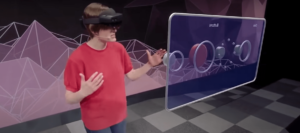How to avoid business transformation failure by using Design Thinking Strategy
- September 08
- 6 min

The digitalization trend, which is one of the important aspects of the Fourth Industrial Revolution, brings not only opportunities but also numerous threats to the European economy. The industry has been the backbone of the EU economy for several decades. Member states are pressing the European Commission to present a new EU industrial strategy (Industry 4.0) by the end of this year (2022).
Germany and France are making the most concrete proposals. They want the protection of the common market from unfair external competition and financial support for new technologies. The implementation of this vision could enable the formation of European champions capable of competing with global players. Read about what Industry 4.0 is, the challenges posed to SMEs and the IT industry, UX in the AI-based fourth industrial revolution and the role of UX & Business Strategy.
The fourth industrial revolution, characterized by the widespread use of the Internet of Things, artificial intelligence and other digital technologies in all spheres of the economy, is leading to market transformations that threaten the position of European industrial players.
For the EU, and Germany in particular, the challenge is the entry of new innovative leaders and IT giants into the automotive sector, with ambitious plans to create autonomously driving cars fully integrated with digital technologies.
Learn why should automotive IT companies be TISAX compliant
Europe’s engineering industry, on the other hand, fears competition from China, which is rapidly catching up, with ample financial resources to develop innovations and buy out foreign technologies. The EU state’s answer to the coming challenges is the concept of Industry 4.0, that is, the development of integral manufacturing plants capable of autonomous coordination of production processes among each other.
European companies are expected to gain a leading position in the market for smart appliances and autonomous cars, urban mobility systems, complex systems for generating energy from renewable sources and improving energy efficiency. This requires a radical change in the existing business models of European manufacturers, increasing their competence in the application of digital technologies and guaranteeing them access to modern IT infrastructure and the necessary data.
First, European manufacturers must be able to abandon their existing business models and be among the pioneers of change. Only in this way can they respond flexibly and quickly to market changes, including the emergence of entirely new competitors.
Secondly, machinery and equipment manufacturers, especially in the SME sector, need to focus on increasing their competence in software production. In addition, they need to acquire the skills to saturate their products with digital technologies, as well as gain access to the appropriate IT infrastructure and the necessary data.
A major challenge in Europe is to get traditional industrial concerns and the IT industry to cooperate in developing joint products. This is necessary because the greatest opportunities for an innovative European economy are opening up in areas such as the production of autonomous cars, the so-called Internet of Things, new sales channels, logistics, Industry 4.0, where competencies from both areas are required.
One big call for European companies in the fourth industrial revolution will be the successful use of artificial intelligence. More and more companies in North America and Asia are monetizing not only one-off production but also services and developing products during their life cycle. “Hiring” the Internet of Things and artificial intelligence allows us to assume with a high probability that they will generate a number of optimizations and ideas for improving production.
Artificial intelligence, however, will not bring anything of value to the fourth industrial revolution without good UX. For this, research is needed, tailored to the type of situation being investigated (a voice interface will be studied differently, a chat-bot will require a different approach, and a manufacturing application assisted by AI will need another angle).
It is important to remember that the process of designing is supposed to be focused on the user. The project designers should ask themselves – how to make the user’s interaction with AI as satisfying as possible. Part of the new role of designers will be not only to create user-friendly interfaces but also to anticipate and prevent problems that users may encounter when using AI.
The next stage is evaluation, in which we test the user experience of the initial AI prototype. When testing the prototype, it is important to consider that this will not examine the technical aspects of the application or interface (loading time, all interactions, etc.). Instead, you can check the overall concept, the comprehensibility of elements and mechanisms, the terminology used.
When testing AI-based interfaces, a certain variation of task-based usability testing called Wizard of Oz will work well. Testing the assumptions of the prototype using this method is much cheaper and more beneficial at the beginning of the design process than implementing the application.
This method takes its name from the role of the tester, who (like the Wizard) generates the answers instead of the computer. The tester usually sits in a separate room, invisible to the research participant, observing the behavior and generating corresponding responses from the system. This allows the user to behave more naturally. However, such a study requires the preparation of a special prototype for the researcher to control. What’s important about this approach is that the content is tailored to the specific user, rather than universal and predetermined.
Once the solution is implemented, it is a good idea to also test extreme cases to see how the technology will behave in unusual situations. Sometimes a designer or researcher is not able to predict every event. That’s when feedback from users comes into play.
Learn more about the importance of user research
Applying the right UX methods in AI-driven Industry 4.0 can greatly enhance the value of digital transformation. Where should we always start when planning digital transformation with the help of AI?
To begin with, it would be helpful to consider the challenges artificial intelligence designers have to overcome for Industry 4.0. We can ponder endlessly on examples of the challenges UX designers face when planning interfaces, and here are just some of them:



What is the biggest challenge? AI blindly learns from data, the famous ‘Chihuahua or Muffin?’ – the meme is one the examples.

Understanding the context
The result provided by AI is simply a statistical observation and pattern recognition. What’s missing is understanding.
Understanding of Interaction
AI provides specific results/estimates. How to build a user path based on them?
Gaining the user’s trust
Would you reuse an assistant that failed you?

It is important to understand that researching and implementing AI through UX research methods is not enough to make digital transformation in Industry 4.0 successful. To plan the transformation more effectively, one needs to plan a broader business and technology strategy.
This is where different methodologies and design approaches come to the rescue, and one of them is UX & Business Strategy, which gives much more possibilities and allows us to define and focus on solving a real problem from the point of view of different stakeholders in the transformation process: business, market, competitors, employees and users. Planning such a strategy can be summed up in a few general steps:
Being data-first, defining strategy, conducting product discovery, setting metrics, and optimizing.
The whole strategic approach was explained in detail in the previous article: How to avoid business transformation failure by using Design Thinking Strategy. Feel invited to take a read!
Having a defined strategy and meticulous execution of it allows for effective digital transformation. Industry 4.0 is the future. The key is to create the right partnership with an IT partner who understands the objectives and assumptions.
